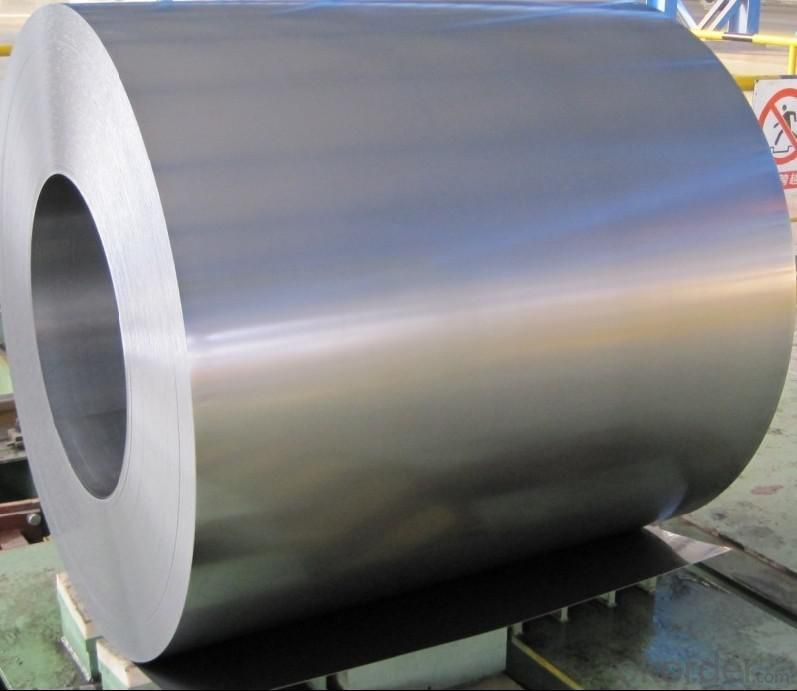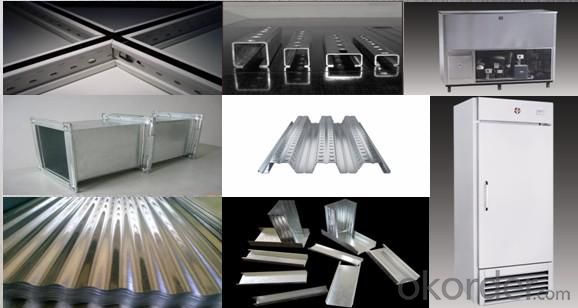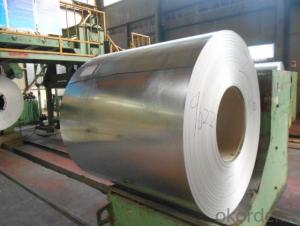Galvanized Steel Coil with Best Quality from China
- Loading Port:
- Tianjin
- Payment Terms:
- TT or LC
- Min Order Qty:
- 50 m.t.
- Supply Capability:
- 5000 m.t./month
OKorder Service Pledge
OKorder Financial Service
You Might Also Like
Hot-dip Zinc Coating Steel Building Roof Walls
1.Structure of Hot-Dip Galvanized Steel Sheet Description:
Hot-dip galvanized steel coils are available with a pure zinc coating through the hot-dip galvanizing process. It offers the economy, strength and formability of steel combined with the corrosion resistance of zinc. The hot-dip process is the process by which steel gets coated in layers of zinc to protect against rust. It is especially useful for countless outdoor and industrial applications. Production of cold formed corrugated sheets and profiles for roofing, cladding, decking, tiles, sandwich walls, rainwater protective systems, air conditioning duct as well as electrical appliances and engineering.
2.Main Features of the Hot-Dip Galvanized Steel Sheet:
• Excellent process capability
• Smooth and flat surface
• Workability, durability
• Excellent anticorrosive property
• High strength
• Good formability
• Good visual effect
3.Hot-Dip Galvanized Steel Sheet Images:


4.Hot-Dip Galvanized Steel Sheet Specification:
Standard: ASTM, JIS,EN
Grade: CS, DX51D+Z,SGCC, SS 230~550,S220GD+Z~S550GD+Z, SGC340~SGC570
Thickness: 0.1mm~5mm
Width: max 2000mm
Coil weight:3-12 MT
Coil ID:508/610mm
Surface structure: zero spangle, regular spangle or minimum spangle
Surface treatment: Chromate treatment, Oiled/dry, skinpassed/non-skinpassed
Packing: Standard seaworthy export package
Technology test results:

5.FAQ of Hot-Dip Galvanized Steel Sheet:
We have organized several common questions for our clients,may help you sincerely:
1.How about your company?
A world class manufacturer & supplier of castings forging in carbon steel and alloy steel,is one of the large-scale professional investment casting production bases in China,consisting of both casting foundry forging and machining factory. Annually more than 8000 tons Precision casting and forging parts are exported to markets in Europe,America and Japan. OEM casting and forging service available according to customer’s requirements.
2.How to guarantee the quality of the products?
We have established the international advanced quality management system,every link from raw material to final product we have strict quality test;We resolutely put an end to unqualified products flowing into the market. At the same time, we will provide necessary follow-up service assurance.
3. How long can we receive the product after purchase?
Usually within thirty working days after receiving buyer’s advance payment or LC. We will arrange the factory manufacturing as soon as possible. The cargo readiness usually takes 15-30 days, but the shipment will depend on the vessel situation.
- Q:How do you remove rust or corrosion from stainless steel sheets?
- In order to eliminate rust or corrosion from stainless steel sheets, the following steps can be followed: 1. Initiate the process by cleansing the surface of the stainless steel sheet using a mild detergent and warm water. This will eradicate any dirt or grease that may potentially impede the rust removal procedure. 2. Subsequently, ensure the sheet is thoroughly dried to prevent any further water damage and to guarantee the effectiveness of the rust removal process. 3. Proceed by utilizing a non-abrasive scrubbing pad or a soft cloth to apply a stainless steel cleaner or a homemade solution comprising equal parts vinegar and water. Gently rub the affected area in the direction of the grain of the stainless steel. 4. If the rust or corrosion persists, experiment with a paste formed from baking soda and water or a mixture of cream of tartar and water. Apply this paste to the affected region and allow it to sit for approximately 15 minutes. Then, delicately scrub the area with a soft cloth or a non-abrasive scrubbing pad. 5. If the aforementioned methods do not completely eliminate the rust or corrosion, consider using a commercial rust remover specifically formulated for stainless steel. Make sure to adhere to the manufacturer's instructions and adopt suitable safety precautions. 6. Once the rust or corrosion has been eradicated, rinse the stainless steel sheet thoroughly with clean water and completely dry it to prevent any water spots or further damage. 7. To prevent future rust or corrosion, it is advisable to regularly clean and maintain stainless steel surfaces using non-abrasive cleaners and avoiding harsh chemicals or abrasive materials. Always remember to conduct a test of any cleaning solution or rust remover on a small and inconspicuous area of the stainless steel sheet prior to applying it to the entire surface, to ensure it does not cause any damage or discoloration.
- Q:What is the minimum order quantity for stainless steel sheets?
- The minimum order quantity for stainless steel sheets can vary depending on the supplier and the specific product. However, it is common for suppliers to have a minimum order quantity ranging from 1 to 10 sheets. It is important to contact different suppliers and inquire about their minimum order requirements to find the best option that suits your needs.
- Q:How do stainless steel sheets differ from other types of metal sheets?
- Stainless steel sheets differ from other types of metal sheets in several ways. Firstly, stainless steel is an alloy that contains a minimum of 10.5% chromium. This chromium content forms a protective layer of chromium oxide on the surface of the metal, making it highly resistant to corrosion and staining. This unique property sets stainless steel sheets apart from other metals, as they can withstand exposure to harsh environments, chemicals, and moisture without deteriorating. Secondly, stainless steel sheets offer excellent strength and durability. Due to their composition, stainless steel sheets are highly resistant to heat, impact, and wear. This makes them suitable for a wide range of applications, including automotive, construction, and industrial settings, where strength and endurance are crucial. Another important distinction is the aesthetic appeal of stainless steel sheets. They have a sleek and modern appearance, which is highly sought after in architectural and interior design projects. Stainless steel sheets can be easily polished to a mirror-like finish, adding an elegant touch to any space. Moreover, stainless steel sheets are known for their hygiene and cleanliness. They have a non-porous surface that does not absorb moisture, making them resistant to bacteria, mold, and other contaminants. This makes stainless steel sheets the material of choice for kitchen appliances, food processing equipment, and medical devices. Lastly, stainless steel sheets are highly customizable. They can be manufactured in various thicknesses, sizes, and finishes to meet specific requirements. Additionally, stainless steel can be easily formed, welded, and fabricated, allowing for creative designs and customization options. In summary, stainless steel sheets differ from other types of metal sheets due to their exceptional corrosion resistance, strength, durability, aesthetic appeal, hygiene, and customization options. These unique characteristics make stainless steel sheets a versatile and reliable choice for a wide range of applications.
- Q:Can stainless steel sheets be used for solar water heaters?
- Yes, stainless steel sheets can be used for solar water heaters. Stainless steel is a durable and corrosion-resistant material, making it suitable for withstanding the harsh conditions of solar water heating systems. It ensures longevity and reliable performance in capturing and transferring solar energy to heat water efficiently.
- Q:How are stainless steel sheets installed?
- Stainless steel sheets are typically installed by first preparing the surface for installation, ensuring it is clean and free from any debris or contaminants. The sheets are then carefully measured and cut to fit the desired area. Once the sheets are ready, they are usually secured to the surface using various methods such as screws, adhesive, or welding, depending on the specific installation requirements. Proper alignment and a secure attachment are crucial for a successful installation of stainless steel sheets.
- Q:Stainless steel sheet welding method, thickness of 0.5mm
- Welding power university, rated matrix current, peak current, pulse frequency, pulse width and other parameters are not the same.
- Q:Can stainless steel sheets be used in food processing industry?
- Yes, stainless steel sheets can be used in the food processing industry. Stainless steel is a popular choice in this industry because it is resistant to corrosion, easy to clean, and does not react with food or beverages. It is also strong and durable, making it suitable for various applications such as food preparation surfaces, storage containers, and equipment. Additionally, stainless steel sheets have a smooth and non-porous surface, which helps prevent the growth of bacteria and ensures food safety. Overall, stainless steel sheets are a reliable and hygienic choice for use in the food processing industry.
- Q:How do you install stainless steel sheets?
- In order to install stainless steel sheets, there are a few basic tools you will need and some steps that should be followed: 1. Begin by measuring and preparing the area where you intend to install the stainless steel sheets. Ensure that the surface is clean, dry, and free from any dust or debris. If necessary, smooth out any rough spots or imperfections on the surface by sanding them down. 2. Cut the sheets to the desired size and shape using a metal cutting tool such as a circular saw or a jigsaw with a metal cutting blade. For your safety, remember to wear protective goggles and gloves while cutting. 3. Apply a high-strength construction adhesive to the backside of the stainless steel sheet. Ensure that the adhesive is applied evenly, without leaving any gaps or air pockets. To achieve better coverage, you may use a notched trowel to spread the adhesive. 4. Carefully position the stainless steel sheet onto the prepared surface, making sure it is properly aligned. Apply gentle and consistent pressure to ensure that the sheet adheres to the surface. A roller or clean cloth can be used to firmly press the sheet onto the surface. 5. If necessary, use stainless steel screws to further secure the sheet. Place the screws evenly along the edges and corners, ensuring proper spacing. Be cautious not to overtighten the screws in order to avoid damaging the sheet. 6. Trim any excess stainless steel sheet that hangs over the edges to achieve the desired size. Use a metal cutting tool for this task. Once trimmed, smooth out any rough edges with a file or sandpaper. To give the sheet a polished finish and remove any smudges or fingerprints, a stainless steel cleaner can be used. Always make sure to follow the manufacturer's instructions for the specific stainless steel sheets you are using, as installation methods may slightly vary. If you are unsure or uncomfortable with the installation process, it is recommended to seek professional assistance.
- Q:Are stainless steel sheets resistant to hydrogen embrittlement?
- Yes, stainless steel sheets are generally resistant to hydrogen embrittlement. Hydrogen embrittlement is a phenomenon that occurs when hydrogen atoms diffuse into the metal structure, causing it to become brittle and prone to cracking. However, stainless steel has a high resistance to hydrogen embrittlement due to its unique composition and microstructure. The presence of chromium in stainless steel forms a protective oxide layer on the surface, which acts as a barrier to prevent hydrogen diffusion into the metal. Additionally, stainless steel sheets are often alloyed with other elements such as nickel and molybdenum, which further enhance their resistance to hydrogen embrittlement. However, it is important to note that certain conditions, such as exposure to high temperatures or high levels of hydrogen, can still potentially lead to hydrogen embrittlement in stainless steel. Therefore, it is crucial to consider the specific application and operating conditions when determining the suitability of stainless steel sheets in relation to hydrogen embrittlement.
- Q:Can stainless steel sheets be used for heat transfer applications?
- Yes, stainless steel sheets can be used for heat transfer applications. Stainless steel has excellent thermal conductivity, making it suitable for transferring heat efficiently between two surfaces or mediums. It is commonly used in heat exchangers, cookware, and other applications where heat transfer is essential.
1. Manufacturer Overview |
|
|---|---|
| Location | |
| Year Established | |
| Annual Output Value | |
| Main Markets | |
| Company Certifications | |
2. Manufacturer Certificates |
|
|---|---|
| a) Certification Name | |
| Range | |
| Reference | |
| Validity Period | |
3. Manufacturer Capability |
|
|---|---|
| a)Trade Capacity | |
| Nearest Port | |
| Export Percentage | |
| No.of Employees in Trade Department | |
| Language Spoken: | |
| b)Factory Information | |
| Factory Size: | |
| No. of Production Lines | |
| Contract Manufacturing | |
| Product Price Range | |
Send your message to us
Galvanized Steel Coil with Best Quality from China
- Loading Port:
- Tianjin
- Payment Terms:
- TT or LC
- Min Order Qty:
- 50 m.t.
- Supply Capability:
- 5000 m.t./month
OKorder Service Pledge
OKorder Financial Service
Similar products
New products
Hot products
Related keywords





























